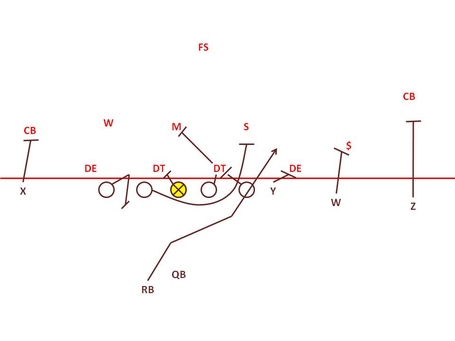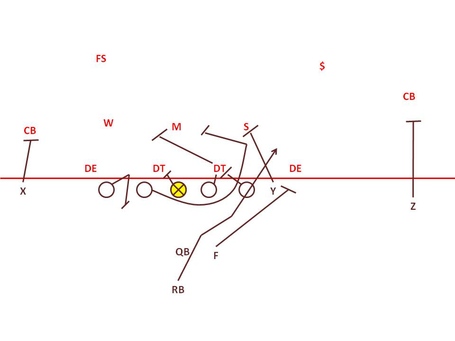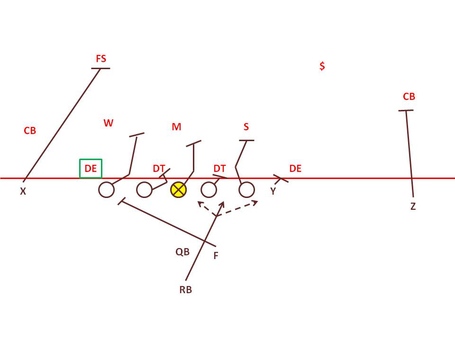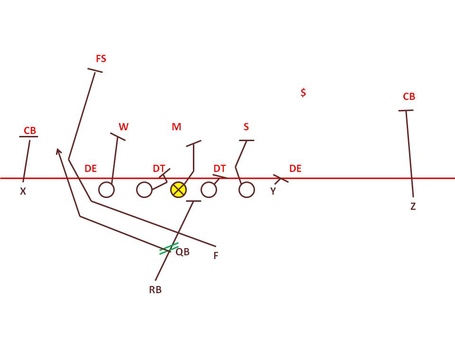Inside the Playbook: Minnesota's Run Attack (Preview)
PREVIEW
Minnesota is one of the most run heavy teams not only in the B1G, but in all of college football. And not only are they just heavy in terms of how much they run the football, but they are the true essence of a team that wants to be a powerful running force. The majority of their runs come between the tackles in the form of inside zone, Power O to the RB, or Power O from the QB. With so much power on the field though, they tend to lack the speed to threaten the edges. Their way of getting the football to the edge then, isn't by subbing in different personnel or by running WR screens, but utilizing in a variety of ways their WRs to run sweeps. Not only has this become prevalent in their offense, but they have used it very well to set up other runs as well. In this article, we will look quickly at the Golden Gophers base run game, and more how they work off of that to set up the rest of their playbook.
Power O
The base scheme for the Golden Gophers is the traditional Power O play. But instead of running it mostly from under center, Minnesota will often run it from a pistol or shotgun formation.
They also will run several variations of Power O: One-back Power, Two-back Power, and QB Power, for instance. For each of these plays, the blocking scheme is more or less the same, the difference usually comes in the backfield.
For instance, here's the one-back Power:
Versus the two-back Power:
Note that the difference is that in a one-back Power, a on-line TE will be the kick out blocker rather than a RB. Now here they are running a QB power:
Note how the QB takes an initial counter step. This allows the RB to get in front and act as a lead blocker, and also allows the pulling OG to get to the hole before the QB.
Inside Zone Read
The inside zone is a staple of the Gopher offense. It works well combined with power, but also produces a downhill running attack. In this case, Minnesota typically pairs it with a read for the QB.
One thing that Minnesota does to take advantage of their mobile QB is to run what looks like a read play, but instead of the FB cutting off the back side, he instead arch blocks to the second level.
In every way this initially looks like an inside zone. But the backside DE is taught to squeeze down on the inside zone while keeping his containment to prevent the QB from escaping. By the FB taking an angle such that he remains below the backside containment, he is essentially walling off the backside DE who is over committing inside, and sealing the second level inside away from the QB. This is a great way to counter the scrape exchange defense, which sends the DE inside while twisting a LB outside to "exchange for the DE". Now both players are taken out of the play, and that's how Minnesota had a lot of success with this last year.
To read on, including to learn about how Minnesota uses the jet sweep to attack the edges, and the jet sweep to set up the play action pass, follow the link to Maize n Brew.
LINK
Minnesota is one of the most run heavy teams not only in the B1G, but in all of college football. And not only are they just heavy in terms of how much they run the football, but they are the true essence of a team that wants to be a powerful running force. The majority of their runs come between the tackles in the form of inside zone, Power O to the RB, or Power O from the QB. With so much power on the field though, they tend to lack the speed to threaten the edges. Their way of getting the football to the edge then, isn't by subbing in different personnel or by running WR screens, but utilizing in a variety of ways their WRs to run sweeps. Not only has this become prevalent in their offense, but they have used it very well to set up other runs as well. In this article, we will look quickly at the Golden Gophers base run game, and more how they work off of that to set up the rest of their playbook.
Power O
The base scheme for the Golden Gophers is the traditional Power O play. But instead of running it mostly from under center, Minnesota will often run it from a pistol or shotgun formation.
They also will run several variations of Power O: One-back Power, Two-back Power, and QB Power, for instance. For each of these plays, the blocking scheme is more or less the same, the difference usually comes in the backfield.
For instance, here's the one-back Power:
Versus the two-back Power:
Note that the difference is that in a one-back Power, a on-line TE will be the kick out blocker rather than a RB. Now here they are running a QB power:
Note how the QB takes an initial counter step. This allows the RB to get in front and act as a lead blocker, and also allows the pulling OG to get to the hole before the QB.
Inside Zone Read
The inside zone is a staple of the Gopher offense. It works well combined with power, but also produces a downhill running attack. In this case, Minnesota typically pairs it with a read for the QB.
One thing that Minnesota does to take advantage of their mobile QB is to run what looks like a read play, but instead of the FB cutting off the back side, he instead arch blocks to the second level.
In every way this initially looks like an inside zone. But the backside DE is taught to squeeze down on the inside zone while keeping his containment to prevent the QB from escaping. By the FB taking an angle such that he remains below the backside containment, he is essentially walling off the backside DE who is over committing inside, and sealing the second level inside away from the QB. This is a great way to counter the scrape exchange defense, which sends the DE inside while twisting a LB outside to "exchange for the DE". Now both players are taken out of the play, and that's how Minnesota had a lot of success with this last year.
* * * * * * *
To read on, including to learn about how Minnesota uses the jet sweep to attack the edges, and the jet sweep to set up the play action pass, follow the link to Maize n Brew.
LINK








Comments
Post a Comment